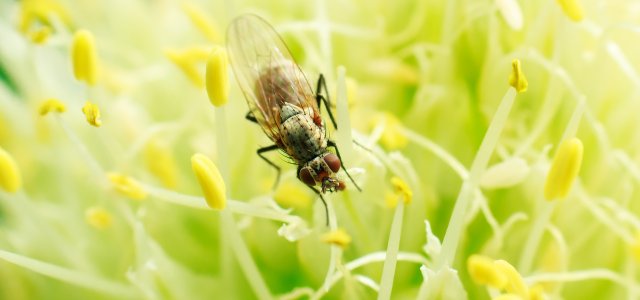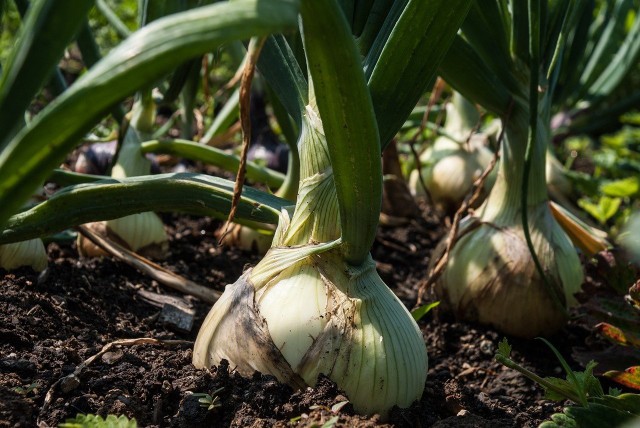Last updated on October 23rd, 2023 at 08:40 pm

The larvae of the onion fly can be especially dangerous for your vegetable patch. We show you how to protect your plants from the fly and how to fight it.
Contents
Onion fly: How to recognize them
- The onion fly belongs to the family of flower flies and is anything but a welcome guest for hobby gardeners. Especially the tiny larvae of the fly prefer to attack various bulbous plants. If you want to prevent your garden from falling victim to the onion fly, you should know what the pests look like and how they live:
Adult onion fly
- The adult onion fly outwardly resembles a house fly and grows up to seven millimeters long. Their light gray body is covered with dark hairs. The shield between their wing attachments is yellow.
- Once the female fly has strengthened herself sufficiently, she lays her eggs in the soil near young bulbous plants in May.
- Up to three generations may be at work in your vegetable patch each year.
Onion fly larvae
- About 14 days after laying their eggs, onion fly larvae hatch from the eggs and begin feeding on the surrounding plants. One larva may even infest several plants.
- The larvae grow to about one centimeter long, are headless and legless, and have a whitish body.
- They overwinter in reddish-brown pupae that are no more than six millimeters long and lie hidden in the soil.
This is how you recognize an infestation by the onion fly and its larvae:
Wilting young plants: Infested onion and leek plants take on a yellowish-gray color shortly after germination and begin to wilt. You can also pull the diseased plants out of the ground very easily.
Feeding tunnels: On larger plants you can often already see the feeding tunnels of the larvae. These usually emit a foul odor. In addition, the small white maggots are often still in the tunnels.
Besides onions and leeks, the onion fly also endangers planted chives and garlic. In rare cases, the larvae of the pest even infest tulips.
Prevent infestation by the onion fly

Once your plants are infested by the larvae of the onion fly, major crop failures are usually not long in coming. Therefore, you should take preventive measures as early as possible to protect your garden from the pests:
- Crop protection nets: The easiest way to keep the onion fly away from your plants is with a cotton vegetable protection net. Cover all your onion plants completely and without gaps with the close-meshed nets. Be sure to loosen the netting periodically so that it does not interfere with the growing plants. It is best to cover your plants with the nets from the beginning of April until harvest to protect them optimally from the egg-laying of the onion fly.
- Encourage predators: The natural enemies of the onion fly are spiders, runners and ichneumon wasps. You can even buy these at garden supply stores or online – for example, at Avocadostore**. Then, to keep them in your garden and attract other beneficial insects, keep your beds and lawns as natural and diverse as possible. You can also build an insect hotel to provide shelter for the helpers.
- Remove rotten bulbs: If you discover rotten bulbs in your bed, you should always dispose of them as quickly as possible. This way you provide the pest with as few food sources as possible.
- No strong-smelling fertilizers: Even if fresh manure is a good source of nutrients for your plants, it is better to avoid such strong-smelling fertilizers. Their odor often attracts the onion fly. Instead, provide your onion plants with homemade plant teas made from wormwood or tansy.
- Mixed crops, crop rotation and crop rotation: Make sure that you keep the crop rotation in your garden bed and never sow your onion plants in the same place two years in a row. You can also deter the pest by growing onions in mixed crops with other vegetables. For example, you can sow carrots or plant parsley. Planted bush beans and cabbage varieties are also suitable for this purpose.
Gently control onion fly
The later you discover the infestation by the onion fly, the more difficult it often becomes to get rid of the pest. Various insecticides are available on the market to quickly kill the fly. However, these products can also harm beneficial insects. So before you reach for the chemical club, you should first resort to biological sprays and gentle measures to combat the onion fly:
- Remove infested plants: If your vegetable patch is infested with the onion fly, the first thing you should do is locate any plants that have already wilted and pull them out of the ground. For them, unfortunately, any help comes too late. To prevent the larvae from spreading to the healthy remaining stock, you should dispose of them as soon as possible. However, do not put them in the compost under any circumstances. Otherwise the pest will spread from there. Instead, it is best to dispose of infested plants in the household waste.
- Biological sprays: Especially in the early stages, you can control the onion fly with purchased or home-made organic preparations. You can make your own nettle liquid manure. Put it on for a maximum of two to three days to get a more odorless broth for your onion plants, which will not affect the taste of the later harvest.


